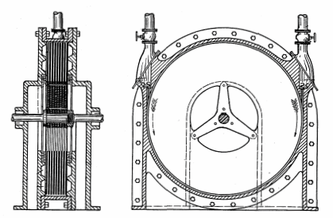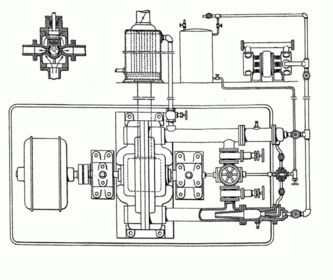Tesla turbine
|
|
The Tesla turbine is a bladeless turbine design patented by Nikola Tesla in 1913. It is referred to as a bladeless turbine because it utilizes the boundary layer effect and not by a fluid impacting the blades in a conventional turbine. The Tesla turbine is also known as the boundary layer turbine, cohesion-type turbine, bladeless turbine, and Prandtl layer turbine (after Ludwig Prandtl).
| Contents |
Pump
If a similar set of disks and a housing with an involute shape (versus circular for the turbine) are used, the device can be used as a pump. In this configuration a motor is attached to the shaft. The fluid enters near the center, is given energy by the disks, then exits at the periphery.
Description
A Tesla turbine consists of a set of smooth disks, with nozzles applying a moving gas to the edge of the disk. The gases drag on the disk by means of viscosity and the adhesion of the surface layer of the gas. As the gas slows and adds energy to the disks, it spirals in to the center exhaust. Since the rotor has no projections, the rotor is very sturdy.
Tesla wrote 'This turbine is an efficient self-starting prime mover which may be operated as a steam or mixed fluid turbine at will, without changes in construction and is on this account very convenient. Minor departures from the turbine, as may be dictated by the circumstances in each case, will obviously suggest themselves but if it is carried out on these general lines it will be found highly profitable to the owners of the steam plant while permitting the use of their old installation. However, the best economic results in the development of power from steam by the Tesla turbine will be obtained in plants especially adapted for the purpose. '
It should be added that this turbine can also be successfully applied to condensing plants operating with high vacuum. In such a case, owing to the very great expansion ratio, the exhaust mixture will be at a relatively low temperature and suitable for admission to the condenser. Better fuel has to be used and special pumping facilities provided but the economic results attained will fully justify the increased outlay.
All the plates and washers are fitted on and keyed to a sleeve threaded at the ends and equipped with nuts and collars for drawing the thick end-plates together or, if desired, the collars may by simply forced onto it and the ends upset. The sleeve has a hole fitting snugly on the shaft and is fastened to the same as usual.
This construction permits free expansion and contraction of each plate individually under the varying influence of heat and centrifugal force and possesses a number of other advantages which are of considerable practical moment. A larger active plate area and consequently more power is obtained for a given width, this improving efficiency. Warping is virtually eliminated and smaller side clearances may be used which results in diminished leakage and friction losses. The rotor is better adapted for dynamic balancing and through rubbing friction resists disturbing influences thereby ensuring quieter running. For this reason and also because the discs are not rigidly joined it is safer against damage which might otherwise be caused by vibration or excessive speed.
The Tesla turbine has the following traits:
- Installation normally working with a mixture of steam and products of combustion and in which the exhaust heat is used to provide steam which is supplied to the turbine, providing a valve governing the supply of such last mentioned steam so that the pressures and temperatures can be adjusted to the optimum working conditions.
A Tesla turbine installation as diagrammed is:
- Able to start with steam alone.
- A disc type adapted to work with fluids at high temperature.
An efficient Tesla turbine requires close spacing of disks. For example, a steam powered type must maintain 0.4 millimeter inter-disk spacing. The disks must be maximally smooth to minimize surface and shear losses. Disks must also be maximally thin to prevent drag and turbulence at disk edges. Unfortunately, preventing disks from warping and distorting was a major challenge in Tesla's time. It is reputed that this inability to prevent the disks distorting contributed to the commercial failure of the turbines, because metallurgy technology had not advanced enough.
Efficiency
In Tesla's time, the efficiency of conventional turbines was low because the aerodynamic theory to proper blade design didn't exist and the engineering materials of the time put severe limitations on operating speeds and temperatures. The efficiency of a conventional turbine is related to the difference in temperature between the intake and the exhaust. This requires that the materials used to construct it be able to withstand very high temperatures for reasonable efficiency.
Tesla's design sidestepped the key drawbacks of the bladed turbine, but does suffer from other problems such as shear losses and flow restrictions. Tesla turbine's advantages lie in the relatively low flow rate and small applications. Maximum efficiency comes in this system when the inter-disk spacing approximates the thickness of the boundary layer, and since boundary layer thickness is dependent on viscosity and pressure, the claim that a single design can be used efficiently for a variety of fuels and fluids is incorrect.
Calculations
A Tesla turbine differs from a conventional turbine only in mechanism used to transfer energy to the blades. Various analyses show that the flow rate between the disks must be kept relatively low to maintain efficiency. This translates to needing to grow the number of disks as the flow rate increases. In addition, the disks need to be as thin as possible at the edges so as not to introduce turbulence as the fluid leaves the disks.
Interestingly, the efficiency of the Tesla turbine goes down with increased load. (Under light load, the spiral taken by the fluid moving from the intake to the exhaust is a tight spiral, undergoing many rotations. Under load, the number of rotations drops and the spiral becomes progressively shorter. This increases the shear losses and reduces the efficiency).
A claim of 95% rotor efficiency (as opposed to overall device efficiency) for this design was published in 1991 by Professor Warren Rice. Rice conducted a bulk-parameter analysis of model laminar flow in multiple disk turbines. This analysis ignored inlet and outlet losses. [1] (http://www.tfcbooks.com/teslafaq/q&a_033.htm) Tesla claimed 98% overall efficiency. In the 1950s, Rice attempted to re-create Tesla's experiments. Rice did not perform his tests on a pump built strictly in line with the Tesla's patented design.
Rice's experimental system was a single stage version of the Tesla turbine. It also used air as the working fluid. Rice's system was not a Tesla multiple staged turbine nor did it possess Tesla's nozzle design. Rice's test turbines, as published in his papers, produced an overall measured efficiency of 36% to 41% (modern multiple stage bladed turbines typically reach 60% - 70% efficiency). [2] (http://my.execpc.com/~teba/debunk/lancaster.html) Rice suggests a maximum fluid power efficiency of approximately 65% for boundary layer turbines may be likely.
Update: Professor Rice's final work, published just prior to his retirement in the early 1990’s, is entitled: "Tesla Turbomachinery." In this 1991 paper Prof. Rice states: "With proper use of the analytical results, the rotor efficiency using laminar flow can be very high, even above 95%.".
Note
The Tesla turbine does not use friction in the conventional sense; it precisely avoids it, and uses adhesion and viscosity instead. It utilizes the boundary layer effect on the disc blades. This is an important point of this invention.
Further reading
- Rice, Warren, "Tesla Turbomachinery". Conference Proceedings of the IV International Tesla Symposium, September 22-25, 1991. Serbian Academy of Sciences and Arts, Belgrade, Yugoslavia.
- Tesla, Nikola, "Dr. Tesla Talks Of Gas Turbines". Motor World. September 18, 1911.
- "The Tesla's steam Turbine". Scientific America, New York. September 30, 1911.
External links and references
Patents:
- US1061206 Turbine (http://phoenixnavigation.com/ptbc/tesla1.htm) - New and useful Improvements in Rotary Engines and Turbines
- US1329559 Valvular Conduit (http://www.tfcbooks.com/patents/valvular.htm) - Includes the Tesla gas turbine
- GB186082 Improvements in the Construction of Steam and Gas Turbines (http://my.execpc.com/~teba/debunk/Patent1.html) - Form of rotor
- GB186083 Economic Transformation of the Energy of Steam by Turbines (http://www.execpc.com/~teba/debunk/Patent2.html) - Tesla turbine system
Photos
- "Tesla turbine". Tesla Wardenclyffe Project : Demonstration model (http://www.teslascience.org/archive/descriptions/picture29.htm) | Experimental turbine-generators (http://www.teslascience.org/archive/descriptions/picture30.htm) | Tesla's turbo-generator I (http://www.teslascience.org/archive/descriptions/picture32.htm) | Tesla's turbo-generator II (http://www.teslascience.org/archive/descriptions/picture33.htm) | Pyle National Company turbine (http://www.teslascience.org/archive/descriptions/picture34.htm)
- "Tesla turbine (http://www.pbs.org/tesla/ll/pv_gen_pop.html)". PBS.
Builders:
- Tesla Engine Builders Association (http://my.execpc.com/~teba/main.html) - Turbine Builders
- Phoenix Turbine Builder (http://www.phoenixnavigation.com/ptbc/home.htm) - Turbine Builders
- Phoenix Navigation & Guidance Inc (http://www.phoenixnavigation.com/ttkit/teslaturbine_kits.htm) - Tesla Turbine Kits
Effect
- "Boundary Layer Effect (http://naca.larc.nasa.gov/reports/1953/naca-report-1124/)". NASA.gov.
Other:
- Redmond, Stephen, "Building a Disk Turbine (http://www.sredmond.com/disk_turbine.htm)".
- "Debunking the Debunker" Part I (http://my.execpc.com/~teba/debunk/lancaster.html) -- Part II (http://my.execpc.com/~teba/debunk/feiereisen.html). Tesla Engine Builders Association (TEBA).
- Germano, Frank D., "Tesla's Bladeless Boundary Disk Turbine and Pump (http://www.frank.germano.com/tesla_turbine.htm)". International Turbine And Power.
- Swithenbank, Alan, "The Tesla Boundary Layer Turbine (http://www.stanford.edu/~hydrobay/lookat/tt.html)". July 19, 2003.
- "Tesla turbine (http://babelfish.altavista.com/babelfish/urltrurl?url=http%3A//www.r-s-design.com/RSD/tes.html&lp=de_en&tt=url)". RS Designs. (original (http://www.r-s-design.com/RSD/tes.html) German)
- Hayes, Jeffery A., "Boundary-layer breakthrough - the Tesla bladeless turbine (http://users.rcn.com/zap.dnai/turbine.txt)".
- Stearns, E. F., "The Tesla Turbine (http://www.lindsaybks.com/arch/turbine/)". Popular Mechanics, December 1911. (Lindsay Publications)
- Allan, Sterling D., and Chris Horianopolous, "Tesla turbine (http://www.greaterthings.com/News/FreeEnergy/Directory/Devices/TeslaTurbine/)". Free Energy.
- "Tesla turbine (http://www.uncletaz.com/library/scimath/tesla/teslaturb.html)". Uncle Taz Library.
- "Tesla Turbine Kit, Turbo-Generator (http://www.obilaser.com/AirPoweredTeslaTurbine.html)".OBI Laser Products.


